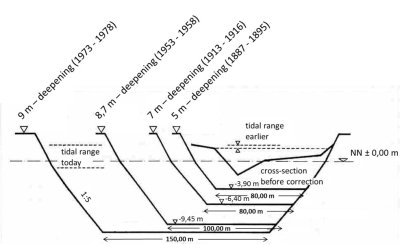 Following recent flooding in Yorkshire and Cumbria many have suggested that the suspension of dredging the lower reaches of river systems is to some extend a causal effect. Without delving too deeply into fluid dynamics here is an attempt to explain how dredging has a limited but negative impact under extreme weather conditions.
Following recent flooding in Yorkshire and Cumbria many have suggested that the suspension of dredging the lower reaches of river systems is to some extend a causal effect. Without delving too deeply into fluid dynamics here is an attempt to explain how dredging has a limited but negative impact under extreme weather conditions.
As a river channel reaches its lower levels toward its estuary the base gradient enters a phase of equilibrium, with the depth required to carry the mean flow capacity maintained by a system of scouring and channel position shift. Main rivers if unconstrained meander through their flood plains at this stage of the development. Shifting from one course to another over time. This equilibrium is unbalanced when human intervention canalises the river course, forcing the river to persist in a specified and limited path. However the base gradient is still maintained and can be seen to follow a roughly consistent gradient towards the outflow.
Intuition would indicate that the mean water level would be lowered under normal conditions by dredging the river bed and intentionally deepening the channel. Unfortunately this is not the case. Although a deeper channel is technically able to carry a greater volume of water in a stable model, this is not the case when you take into account fluid dynamics. A step in the gradients caused by dredging causes turbulence in the flowing water as faster flowing water mixes with the deeper slower moving water column, this is turn reduces the flow rate to one below the rate measured if the river is unaltered. An additional consequence is that this slowed water has less energy and drops it’s sediment load. This results in banks of silt, sands and mud which under flood conditions cause the river to locally overtop its channel. A dredged river will quickly return to a state of equilibrium by the deposition of sediment in the dredged section, however the increase of sediment flow has consequences up steam where the rate of erosion increases proportionally.
It is fair to say the clearing of submerged obstructions has great benefit, but dramatically changing the profile of a river channel by dredging is likely to have unacceptable consequences when the river is in flood and should therefore not be considered as part of a flood prevention strategy.